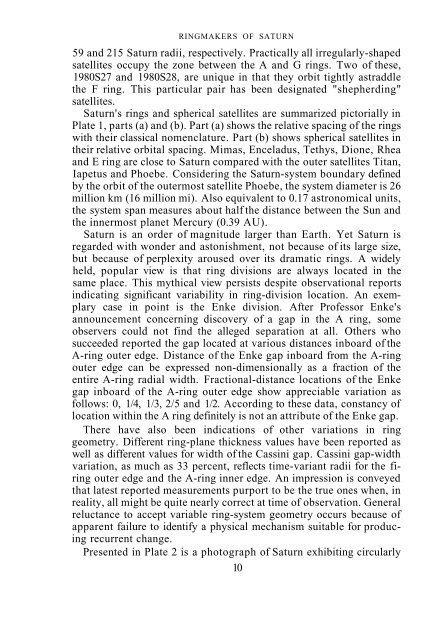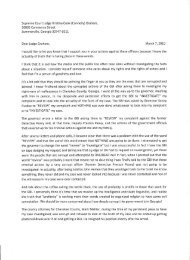Ringmakers of Saturn PDF - Patrick Crusade
Ringmakers of Saturn PDF - Patrick Crusade
Ringmakers of Saturn PDF - Patrick Crusade
You also want an ePaper? Increase the reach of your titles
YUMPU automatically turns print PDFs into web optimized ePapers that Google loves.
RINGMAKERS OF SATURN<br />
59 and 215 <strong>Saturn</strong> radii, respectively. Practically all irregularly-shaped<br />
satellites occupy the zone between the A and G rings. Two <strong>of</strong> these,<br />
1980S27 and 1980S28, are unique in that they orbit tightly astraddle<br />
the F ring. This particular pair has been designated "shepherding"<br />
satellites.<br />
<strong>Saturn</strong>'s rings and spherical satellites are summarized pictorially in<br />
Plate 1, parts (a) and (b). Part (a) shows the relative spacing <strong>of</strong> the rings<br />
with their classical nomenclature. Part (b) shows spherical satellites in<br />
their relative orbital spacing. Mimas, Enceladus, Tethys, Dione, Rhea<br />
and E ring are close to <strong>Saturn</strong> compared with the outer satellites Titan,<br />
Iapetus and Phoebe. Considering the <strong>Saturn</strong>-system boundary defined<br />
by the orbit <strong>of</strong> the outermost satellite Phoebe, the system diameter is 26<br />
million km (16 million mi). Also equivalent to 0.17 astronomical units,<br />
the system span measures about half the distance between the Sun and<br />
the innermost planet Mercury (0.39 AU).<br />
<strong>Saturn</strong> is an order <strong>of</strong> magnitude larger than Earth. Yet <strong>Saturn</strong> is<br />
regarded with wonder and astonishment, not because <strong>of</strong> its large size,<br />
but because <strong>of</strong> perplexity aroused over its dramatic rings. A widely<br />
held, popular view is that ring divisions are always located in the<br />
same place. This mythical view persists despite observational reports<br />
indicating significant variability in ring-division location. An exemplary<br />
case in point is the Enke division. After Pr<strong>of</strong>essor Enke's<br />
announcement concerning discovery <strong>of</strong> a gap in the A ring, some<br />
observers could not find the alleged separation at all. Others who<br />
succeeded reported the gap located at various distances inboard <strong>of</strong> the<br />
A-ring outer edge. Distance <strong>of</strong> the Enke gap inboard from the A-ring<br />
outer edge can be expressed non-dimensionally as a fraction <strong>of</strong> the<br />
entire A-ring radial width. Fractional-distance locations <strong>of</strong> the Enke<br />
gap inboard <strong>of</strong> the A-ring outer edge show appreciable variation as<br />
follows: 0, 1/4, 1/3, 2/5 and 1/2. According to these data, constancy <strong>of</strong><br />
location within the A ring definitely is not an attribute <strong>of</strong> the Enke gap.<br />
There have also been indications <strong>of</strong> other variations in ring<br />
geometry. Different ring-plane thickness values have been reported as<br />
well as different values for width <strong>of</strong> the Cassini gap. Cassini gap-width<br />
variation, as much as 33 percent, reflects time-variant radii for the firing<br />
outer edge and the A-ring inner edge. An impression is conveyed<br />
that latest reported measurements purport to be the true ones when, in<br />
reality, all might be quite nearly correct at time <strong>of</strong> observation. General<br />
reluctance to accept variable ring-system geometry occurs because <strong>of</strong><br />
apparent failure to identify a physical mechanism suitable for producing<br />
recurrent change.<br />
Presented in Plate 2 is a photograph <strong>of</strong> <strong>Saturn</strong> exhibiting circularly<br />
10



